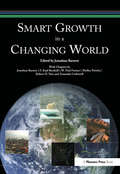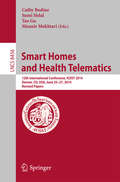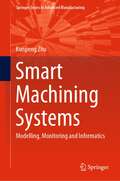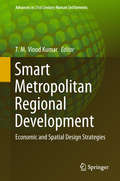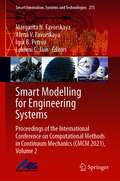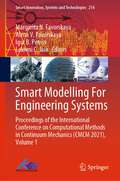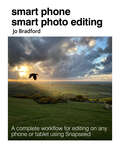- Table View
- List View
Smart Graphics: 6th International Symposium, SG 2006, Vancover, Canada, July 23-25, 2006, Proceedings (Lecture Notes in Computer Science #4073)
by Andreas Butz Brian Fisher Antonio Krüger Patrick OlivierThis book constitutes the refereed proceedings of the 6th International Symposium on Smart Graphics, SG 2006, held in Vancouver, Canada, July 2006. The book presents 19 revised full papers and 8 revised short papers. The papers are organized in topical sections on intelligent text processing, perceptive systems, smart visualization, visual features, sketching and graphical abstraction, intelligent image and film composing, as well as smart interaction.
Smart Graphics: 9th International Symposium, SG 2008, Rennes, France, August 27-29, 2008, Proceedings (Lecture Notes in Computer Science #5166)
by Andreas Butz Brian Fisher Antonio Krüger Patrick Olivier Marc ChristieFor centuries, artists and designers have been creating communicative graphics. With the advent of new forms of media, the emergence of paradigms such as ubiquitous computing, and the rapid evolution of interaction devices, there is a continuous cycle of renewal of the technologies and methods to support artists, interaction designers and developers. Developingnewapproachesrequiresanunderstandingofthe fundamentals of perception and cognition as they relate to interaction and communication te- nologies, together with arti?cial intelligence and computer graphics techniques to automate reasoning and enhance cognition. Smart Graphics is in essence an interdisciplinary endeavor and brings together the ?elds of computer graphics, arti?cial intelligence, cognitive science, graphic design and ?ne art. The International Symposium on Smart Graphics 2008 was held on August 27–29 in Rennes, France. It was the ninth event in a series which originally started in 2000 as an American Association for Arti?cial Intelligence Spring Symposium and has taken place every year since then. Due to the high quality of the papers submitted this year, the ProgramCommittee decided to accept 17 fullpapers(insteadoftheusual15),9shortpapersand3systemdemonstrations. The acceptance rate for full papers was 34%. This year’s meeting included a discussion as to the nature of the shape, contentandfutureoftheevent.Representativesfromdi?erentcommunitieswere invitedtogivetheiropinions,andtheorganizingcommitteewouldliketowarmly thank them here. Such questions as the ongoing viability of the symposium and theconsequencesofco-locatingSmartGraphicswithotherlargerresearchevents led to interesting debates and have prepared the groundwork for what could be the future of the Smart Graphics conference series.
Smart Graphics: 8th International Symposium, SG 2007, Kyoto, Japan, June 25-27, 2007, Proceedings (Lecture Notes in Computer Science #4569)
by Andreas Butz Brian Fisher Antonio Krüger Patrick Olivier Shigeru OwadaThis book constitutes the refereed proceedings of the 8th International Symposium on Smart Graphics, SG 2007, held in Kyoto, Japan in June 2007 jointly with the Visual Computing / Graphics and CAD symposium, which takes place in Osaka, Japan. It covers interaction, lifelike characters and affective computing, knowledge-based graphics generation and interaction, and visualization and graphics algorithms.
Smart Graphics: 4th International Symposium, SG 2004, Banff, Canada, May 23-25, 2004, Proceedings (Lecture Notes in Computer Science #3031)
by Andreas Butz Antonio Krüger Patrick OlivierSmart Graphics: 12th International Symposium, SG 2014, Taipei, Taiwan, August 27-29, 2014, Proceedings (Lecture Notes in Computer Science #8698)
by Marc Christie Tsai-Yen LiThis book constitutes the proceedings of the 12th International Symposium on Smart Graphics, SG 2014, held in Taipei, Taiwan, in August 2014. The 14 full and 4 short papers presented in this volume were carefully reviewed and selected from 26 submissions. They are organized in topical sections named: data visualization; sketching and multi-touch interaction; aesthetics and smart tools for artists; smart tools for 3D contents; and posters.
Smart Graphics: 11th International Symposium on Smart Graphics, Bremen, Germany, July 18-20, 2011. Proceedings (Lecture Notes in Computer Science #6815)
by Lutz Dickmann Gerald Volkmann Rainer Malaka Susanne Boll Antonio Krüger Patrick OlivierThis book constitutes the refereed proceedings of the 11th International Symposium on Smart Graphics, SG 2011, held in Bremen, Germany, in July 2011. The 10 revised full papers presented together with 12 short papers and 4 systems demonstrations were carefully reviewed and selected from numerous submissions covering a wide range of topics including view and camera control; three-dimensional modeling; visual information encoding; video projection; information visualization; interaction techniques; visual communication; and graphics and audio.
Smart Graphics: 13th International Symposium, SG 2015, Chengdu, China, August 26-28, 2015, Revised Selected Papers (Lecture Notes in Computer Science #9317)
by Yaxi Chen, Marc Christie and Wenrong TanThis book constitutes the proceedings of the 13th International Symposium on Smart Graphics, SG 2015, held in Chengdu, China, in August 2015. The 17 full and 3 short papers presented in this volume were carefully reviewed and selected from 35 submissions. They are organized in topical sections named: graphics, sketching and visualization, automation and evaluation, image processing, and posters and demo session.
Smart Grapics: Third International Symposium, SG 2003, Heidelberg, Germany, July2-4, 2003, Proceedings (Lecture Notes in Computer Science #2733)
by Andreas Butz Antonio Krüger Patrick OlivierThe International Symposium on Smart Graphics 2003 was held on July 2–4, 2003 in Heidelberg, Germany. It was the fourth event in a series that started in 1999 as an AAAI Spring Symposium. In response to the overwhelming success of the 1999 symposium, its organizers decided to turn it into a self-contained event in2000. WiththesupportofIBM,the?rsttwoInternationalSymposiaonSmart Graphics were held at the T. J. Watson Research Center in Hawthorne, NY. The 2003 symposium was supported by the Klaus Tschira Foundation and moved to the European Media Lab in Heidelberg, thus underlining the international character of the Smart Graphics enterprise and its community. The core idea behind these symposia is to bring together researchers and practitioners from the ?eld of computer graphics, arti?cial intelligence, cog- tive psychology, and ?ne art. Each of these disciplines contributes to what we mean by the term “Smart Graphics”: the intelligent process of creating expr- sive and esthetic graphical presentations. While artists and designers have been creating communicative graphics for centuries, arti?cial intelligence focuses on automating this process by means of the computer. While computer graphics provides the tools for creating graphical presentations in the ?rst place, cog- tive sciences contribute the rules and models of perception necessary for the design of e?ective graphics. The exchange of ideas between these four discip- nes has led to many exciting and fruitful discussions, and the Smart Graphics Symposia draw their liveliness from a spirit of open minds and the willingness to learn from and share with other disciplines.
Smart Grids and Buildings for Energy and Societal Transition
by Benoît Robyns Christophe Saudemont Hervé Barry Dhaker Abbes Laure Dobigny Benoit DurillonThis book presents interdisciplinary approaches to help buildings, electrical energy networks and their users contribute to the energy and societal transition. Smart Grids and Buildings for Energy and Societal Transition examines the technologies, uses and imaginaries involved in implementing smart buildings and smart grids. Production and consumption forecasts, modeling of stakeholder involvement and self-consumption within a renewable energy community exploiting blockchain technology are examples developed with a view to fostering the emergence of smart grids. The potential of smart buildings, taking into account user comfort while increasing energy efficiency, is identified. Full-scale demonstrators are used to test the proposed solutions, and to ensure that users take full advantage of the potential for electrical flexibility.
Smart Grids and Buildings for Energy and Societal Transition
by Benoît Robyns Christophe Saudemont Hervé Barry Dhaker Abbes Laure Dobigny Benoit DurillonThis book presents interdisciplinary approaches to help buildings, electrical energy networks and their users contribute to the energy and societal transition. Smart Grids and Buildings for Energy and Societal Transition examines the technologies, uses and imaginaries involved in implementing smart buildings and smart grids. Production and consumption forecasts, modeling of stakeholder involvement and self-consumption within a renewable energy community exploiting blockchain technology are examples developed with a view to fostering the emergence of smart grids. The potential of smart buildings, taking into account user comfort while increasing energy efficiency, is identified. Full-scale demonstrators are used to test the proposed solutions, and to ensure that users take full advantage of the potential for electrical flexibility.
Smart Growth in a Changing World
by Jonathan BarnettThis book is the latest book from the author, documents the United States' hidden crisis and shows how balanced transportation and natural resources preservation can make new urban development sustainable, as well as more efficient and more equitable.
Smart Growth in a Changing World
by Jonathan BarnettThis book is the latest book from the author, documents the United States' hidden crisis and shows how balanced transportation and natural resources preservation can make new urban development sustainable, as well as more efficient and more equitable.
Smart Homes and Health Telematics: 12th International Conference, ICOST 2014, Denver, CO, USA, June 25-27, 2014, Revised Papers (Lecture Notes in Computer Science #8456)
by Cathy Bodine Sumi Helal Tao Gu Mounir MokhtariThis book constitutes the thoroughly refereed post-conference proceedings of the 12th International Conference on Smart Homes and Health Telematics, ICOST 2014, held in Denver, CO, USA in June 2014.The 21 revised full papers presented together with three keynote papers and 9 short papers were carefully reviewed and selected from numerous submissions. The papers are organized in topical sections on Design and Usability, assistive and sentient environments, cognitive technology, activity recognition, context and situation awareness, Health IT and short contributions.
Smart Machining Systems: Modelling, Monitoring and Informatics (Springer Series in Advanced Manufacturing)
by Kunpeng ZhuThis book provides the tools to enhance the precision, automation and intelligence of modern CNC machining systems. Based on a detailed description of the technical foundations of the machining monitoring system, it develops the general idea of design and implementation of smart machining monitoring systems, focusing on the tool condition monitoring system. The book is structured in two parts. Part I discusses the fundamentals of machining systems, including modeling of machining processes, mathematical basics of condition monitoring and the framework of TCM from a machine learning perspective. Part II is then focused on the applications of these theories. It explains sensory signal processing and feature extraction, as well as the cyber-physical system of the smart machining system. Its utilisation of numerous illustrations and diagrams explain the ideas presented in a clear way, making this book a valuable reference for researchers, graduate students and engineers alike.
Smart Materials and Technologies in Architecture
by Michelle Addington Daniel SchodekToday, architects and designers are beginning to look toward developments in new"smart" or "intelligent" materials and technologies for solutions to long-standing problemsin building design. However, these new materials have so far been applied in a diversebut largely idiosyncratic nature, because relatively few architects have access toinformation about the types or properties of these new materials or technologies.Two of the leading experts in this field - Addington and Schodek - have solved thisproblem by incorporating all the relevant information of all the latest technologiesavailable to architects and designers in this one volume. They present materials bydescribing their fundamental characteristics, and go on to identify and suggest howthese same characteristics can be exploited by professionals to achieve their designgoals. Here, the wealth of technical understanding already available in the materialsscience and engineering literature is at last made accessible to a design audience.
Smart Materials and Technologies in Architecture: For The Architecture And Design Professions
by Michelle Addington Daniel SchodekToday, architects and designers are beginning to look toward developments in new"smart" or "intelligent" materials and technologies for solutions to long-standing problemsin building design. However, these new materials have so far been applied in a diversebut largely idiosyncratic nature, because relatively few architects have access toinformation about the types or properties of these new materials or technologies.Two of the leading experts in this field - Addington and Schodek - have solved thisproblem by incorporating all the relevant information of all the latest technologiesavailable to architects and designers in this one volume. They present materials bydescribing their fundamental characteristics, and go on to identify and suggest howthese same characteristics can be exploited by professionals to achieve their designgoals. Here, the wealth of technical understanding already available in the materialsscience and engineering literature is at last made accessible to a design audience.
Smart Metropolitan Regional Development: Economic and Spatial Design Strategies (Advances in 21st Century Human Settlements)
by T.M. Vinod KumarThis book discusses the concept and practice of a smart metropolitan region, and how smart cities promote healthy economic and spatial development. It highlights how smart metropolitan regional development can energize, reorganize and transform the legacy economy into a smart economy; how it can help embrace Information and Communications Technology (ICT); and how it can foster a shared economy. In addition, it outlines how the five pillars of the third industrial revolution can be achieved by smart communities. In addition, the book draws on 16 in-depth city case studies from ten countries to explore the state of the art regarding the smart economy in smart cities – and to apply the lessons learned to shape smart metropolitan economic and spatial development.
Smart Modelling for Engineering Systems: Proceedings of the International Conference on Computational Methods in Continuum Mechanics (CMCM 2021), Volume 2 (Smart Innovation, Systems and Technologies #215)
by Margarita N. Favorskaya Alena V. Favorskaya Igor B. Petrov Lakhmi C. JainThis book is a collection of research papers selected for presentation at the International Conference on Smart Computational Methods in Continuum Mechanics 2021, organized by Moscow Institute of Physics and Technology and the Institute for Computer Aided Design of Russian Academy of Sciences. The work is presented in two volumes. The primary objective of the book is to report the state-of-the-art on smart computational paradigms in continuum mechanics and explore the use of artificial intelligence paradigms such as neural nets and machine learning for improving the performance of the designed engineering systems. The book includes up-to-date smart computational methods which are used to solve problems in continuum mechanics, engineering, seismic prospecting, non-destructive testing, and so on. The main features of the book are the research papers on the application of novel smart methods including neural nets and machine learning, computational algorithms, smart software systems, and high-performance computer systems for solving complex engineering problems. The case studies pertaining to the real-world applications in the above fields are included. The book presents a collection of best research papers in English language from some of the world leaders in the field of smart system modelling and design of engineering systems.
Smart Modelling For Engineering Systems: Proceedings of the International Conference on Computational Methods in Continuum Mechanics (CMCM 2021), Volume 1 (Smart Innovation, Systems and Technologies #214)
by Lakhmi C. Jain Margarita N. Favorskaya Alena V. Favorskaya Igor B. PetrovThis book is a collection of research papers selected for presentation at the International Conference on Smart Computational Methods in Continuum Mechanics 2021, organized by Moscow Institute of Physics and Technology and the Institute for Computer Aided Design of Russian Academy of Sciences. The work is presented in two volumes. The primary objective of the book is to report the state-of-the-art on smart computational paradigms in continuum mechanics and explore the use of artificial intelligence paradigms such as neural nets, and machine learning for improving the performance of the designed engineering systems. The book includes up-to-date smart computational methods which are used to solve problems in continuum mechanics, engineering, seismic prospecting, non-destructive testing, and so on. The main features of the book are the research papers on the application of novel smart methods including neural nets and machine learning, computational algorithms, smart software systems, and high-performance computer systems for solving complex engineering problems. The case studies pertaining to the real-world applications in the above fields are included. The book presents a collection of best research papers in English language from some of the world leaders in the field of smart system modelling and design of engineering systems.
Smart Multimedia: Third International Conference, ICSM 2022, Marseille, France, August 25–27, 2022, Revised Selected Papers (Lecture Notes in Computer Science #13497)
by Guan-Ming Su Stefano BerrettiThis book constitutes the proceedings of the Third International Conference on Smart Multimedia, ICSM 2022, which was held in Marseille, France, during August 25–27, 2022.The 30 full papers and 4 short paper presented in this volume were carefully reviewed and selected from 68 submissions. The contributions were organized in topical sections as follows: Machine Learning for Multimedia; Image Processing; Multimedia Applications; Multimedia for Medicine and Health-Care; Smart Homes; Multimedia Environments and Metaverse; Deep Learning on Video and Music; Haptic; Industrial.
Smart Objects and Technologies for Social Good: Second International Conference, GOODTECHS 2016, Venice, Italy, November 30 – December 1, 2016, Proceedings (Lecture Notes of the Institute for Computer Sciences, Social Informatics and Telecommunications Engineering #195)
by Ombretta Gaggi Pietro Manzoni Claudio Palazzi Armir Bujari Johann M. Marquez-BarjaThis book constitutes the proceedings of the Second EAI international Conference on Smart Objects and Technologies for Social Good, GOODTECHS 2016, held in Venice, Italy, November 30 – December 1, 2016. The 38 revised full papers were carefully reviewed and selected from 73 submissions. The papers reflect the design, implementation, deployment, operation and evaluation of smart objects and technologies for social good. A social good can be understood as a service that benefits a large number of people in a most possible way. Some classic examples are healthcare, safety, environment, democracy, and human rights, or even art, entertainment, and communication.
Smart Phone Smart Photo Editing
by Jo BradfordLearn how to edit photographs on your phone with this step-by-step guide from professional photographer Jo Bradford. Do you know how to make the best of the photos you’ve taken with your phone? We all have hundreds of images on our phones that could do with a little improvement, but transferring them to a hard drive and working in an out-of-date editing program on your Mac or PC can seem like too much hassle. Award-winning professional photographer Jo Bradford, author of the bestselling Smart Phone Smart Photography, can show you how to edit your photos easily and conveniently on your iPhone or Android, using the free Snapseed app. Smart Phone Smart Photo Editing shows you how to use the app to do everything from raw developing and saving a copy, to compositional improvements, global enhancements to colour and other elements, and smaller adjustments to specific details. With clear step-by-step text and illustrations for each process, you will soon learn how to get the best from the app and from your images. Case studies and beautiful images taken by Jo will also help to inspire you in your photography.
Smart Phone Smart Photography: Simple techniques for taking incredible pictures with iPhone and Android
by Jo Bradford“... a genuinely useful guide to the more technical side of phone shooting, including editing with popular apps like Snapseed. Jo Bradford makes the most of the creative possibilities of modern smartphone cameras, and her tips on improving exposure and ensuring decent prints are really useful.” Awarded 5 stars by Amateur Photographer Maximize your potential to get the shots you want with this guide to photography for both Apple and Android phones.There’s a saying that the best camera for the job is the one you have with you when an opportunity arises. Thanks to the boom in camera-phone technology, today we’re lucky enough to have a camera to hand to capture all those incredible moments. But are you making the most of that powerful tool in your pocket? Do the photos you have taken tend to be blurry, or look nothing like what you're seeing? If you want to shoot incredible images with your phone, buy Smart Phone, Smart Photography.Covering simple techniques that will allow you to get the image that you see every single time, you will soon be telling your camera what to do with confidence. Start with The Big Picture and get to know your camera phone and the rules behind taking the perfect shot. The next chapter, Taking Great Pictures, explains the key disciplines of photography – portrait, abstraction, macro, still life and plenty more. Finally, the Post-production chapter demonstrates how to use apps to edit and enhance your images and create incredible prints for display.
Smart Technologies and Design For Healthy Built Environments (Springerbriefs In Applied Sciences And Technology Ser.)
by Ming HuSmart Technologies and Design for Healthy Built Environment connects smart technology to a healthy built environmentthat builds upon the sustainable building movement.It provides an overall summary of the state-of-the-art technologies that are applied in the built environment. The book covers a broad spectrum of smart technology categories ranging from dynamic operability, energy efficiency, self-regulating and self-learning systems, and responsive systems. The foreseeable challenges that are associated with smart technologies are discussed and outlined in the book. Firstly, this book provides a snapshot of state-of-the-art smart technologies being applied in the built environment. It covers a broad spectrum of smart technology categories, ranging from dynamic operability, energy efficiency, self-regulating and self-learning systems, to responsive systems. Secondly, this book provides in-depth analysis of the four primary components of health (biological, physical, physiological and psychological); their effects on wellbeing and cognitive performance are introduced as well. Thirdly, it connects smart technologies to those health-influencing factors by reviewing three completed smart building projects. This book can also serve as a basis for education and discussion among professionals and students of diverse backgrounds who are interested in smart technologies, smart building, and healthy building. Smart Technologies and Design for Healthy Built Environment serves as the basis for education and discussions among professionals and students who are interested in smart technologies, smart building and healthy building, as it bridges the gap between smart technologies and a healthy built environment. The book also provides a foundation for anyone who is interested in the impact of smart technology on the health of built environment.
Smart Technologies for Energy, Environment and Sustainable Development: Select Proceedings of ICSTEESD 2018 (Lecture Notes on Multidisciplinary Industrial Engineering)
by Mohan Lal Kolhe Pawan Kumar Labhasetwar H. M. SuryawanshiThis book comprises select proceedings of the International Conference on Smart Technologies for Energy, Environment, and Sustainable Development (ICSTEESD 2018). The chapters are broadly divided into three focus areas, viz. energy, environment, and sustainable development, and discusses the relevance and applications of smart technologies in these fields. A wide variety of topics such as renewable energy, energy conservation and management, energy policy and planning, environmental management, marine environment, green building, smart cities, smart transportation are covered in this book. Researchers and professionals from varied engineering backgrounds contribute chapters with an aim to provide economically viable solutions to sustainable development challenges. The book will prove useful for academics, professionals, and policy makers interested in sustainable development.









